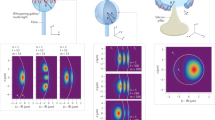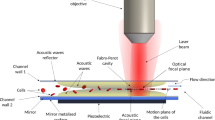Abstract
During the past decade, whispering gallery modes (WGMs) have been proven to enable highly sensitive microscopic optical sensors capable of in-vitro label-free bio-detection under physiological conditions. While the basic aspects of this quite novel and promising approach have been explored, it still lacks implementation at a level that would effectively rival well-established state-of-the-art biosensor systems, such as Surface Plasmon Resonance sensors and Quartz Crystal Microbalance.
In this work, we present a fully automated in-vitro diagnostics system based on low-Q whispering gallery modes designed to accept this challenge. Starting from the principles of low-Q WGM sensing, various aspects and intricacies of implementing a fully fletched in-vitro diagnostics system are discussed with special foci on WGM analysis and numerical evaluation, sensor conditioning, fluid handling, and control of the overall device. First results of the performance of the system are presented and interpreted in view of the method’s potential.
Similar content being viewed by others
References
F. Vollmer, D. Braun, A. Libchaber, M. Khoshsima, I. Teraoka, S. Arnold, Appl. Phys. Lett. 80, 4057 (2002)
F. Vollmer, S. Arnold, D. Braun, I. Teraoka, A. Libchaber, Biophys. J. 85, 1974 (2003)
S. Arnold, R. Ramjit, D. Keng, V. Kolchenko, I. Teraoka, Faraday Discuss. 137, 65 (2008)
H.-C. Ren, F. Vollmer, S. Arnold, A. Libchaber, Opt. Express 15, 17410 (2007)
F. Vollmer, S. Arnold, Nat. Meth. 5, 591 (2008)
See, for example, http://genalyte.com, http://www.generabiosystems.corporateit.com.au, http://www.novawavetech.com
S.C. Hill, R.E. Benner, C.K. Rushford, P.R. Conwell, Appl. Opt. 23, 1680 (1984)
A.N. Oraevsky, Quant. Electron. 32, 377 (2002)
For numerical evaluation of Eqs. (2-4) as presented throughout the article as well as control of the instrument in automated measurements, Matlab copyright 2013b by The MathWorks, Inc., 3 Apple Hill Drive Natick, MA 01760-2098, USA, was applied
S. Pang, R.E. Beckham, K.E. Meissner, Appl. Phys. Lett. 92, 221108 (2008)
P. Zijlstra, K.L. van der Molen, A.P. Mosk, Appl. Phys. Lett. 90, 161101 (2007)
Polystyrene microparticles in the size range as applied in the present article are typically fabricated in a two step process, in which first a seed particle of small size (up to few microns) is fabricated and then further grown in a second polymerization step. With increasing size, the growth becomes less homogeneous, and also the inner tensions increase. Both effects would cause deviations of particle shape from ideal sphericity, which in turn would result in a mode splitting and thus a broadening of the modes’ bandwidths
M. Himmelhaus, A. Francois, Biosens. Bioelectron. 25, 418 (2009)
M. Himmelhaus, S. Krishnamoorthy, A. Francois, Sensors 10, 6257 (2010)
According to Eq. (1), a change an adlayer with thickness of 1 nm would yield a mode shift of 0.1 nm for a mode at 500 nm and a WGM sensor of 10 μm in diameter. Allowing for some dynamic range in the measurement, the resolution of the detection system should be smaller than this at least by a factor of 8
C. Peyratout, L. Dähne, Angew. Chem. Int. Ed. 43, 3762 (2004)
G. Decher, J.B. Schlenoff (eds.), Multilayer Thin Films: Sequential Assembly of Nanocomosite Materials (Wiley-VCH, Weinheim, 2003)
J. Kang, M. Loew, A. Arbuzova, I. Andreou, L. Dähne, Adv. Mater. 22, 3548 (2010)
M. Loew, J. Kang, L. Dähne, R. Hendus-Altenburger, O. Kaczmarek, J. Liebscher, D. Huster, K. Ludwig, Ch. Böttcher, A. Herrmann, A. Arbuzova, Small 5, 320 (2009)
A. Francois, M. Himmelhaus, Sensors 9, 6836 (2009)
Author information
Authors and Affiliations
Corresponding author
Rights and permissions
About this article
Cite this article
Bischler, R., Olszyna, M., Himmelhaus, M. et al. Development of a fully automated in-vitro diagnostics system based on low-Q whispering gallery modes in fluorescent microparticles. Eur. Phys. J. Spec. Top. 223, 2041–2055 (2014). https://doi.org/10.1140/epjst/e2014-02247-2
Received:
Revised:
Published:
Issue Date:
DOI: https://doi.org/10.1140/epjst/e2014-02247-2




